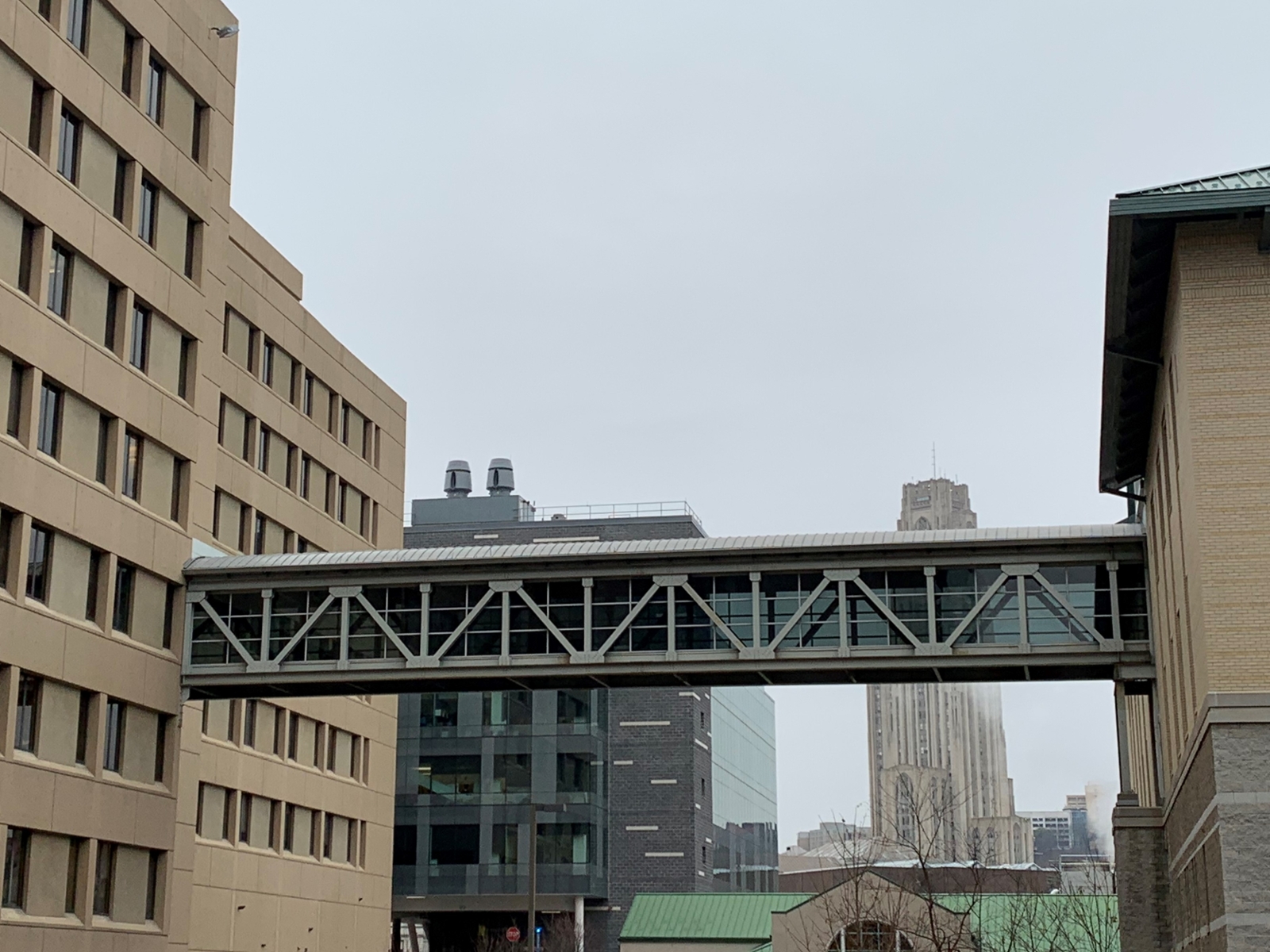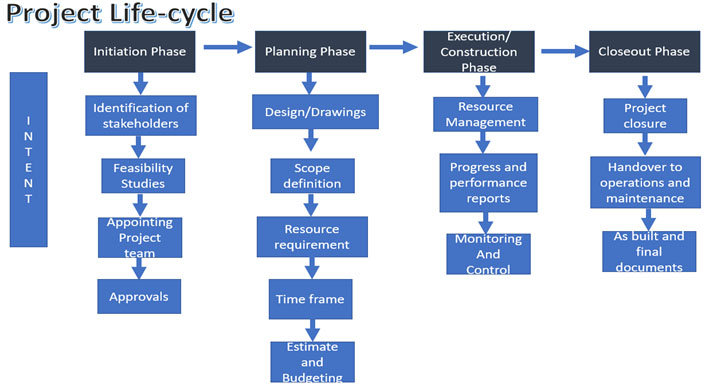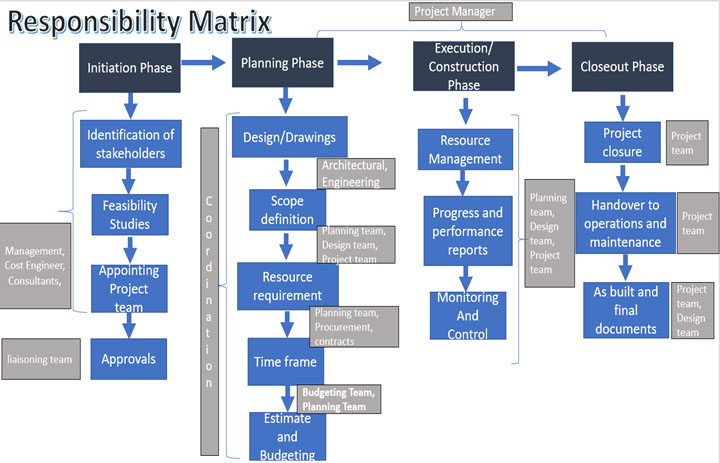Lesson title: Bridges, Life-cycle of an Infrastructure Project

A footbridge between two buildings; Carnegie Mellon University, Pittsburgh, PA.
Brief Summary: Students are familiar with bridges, buildings and other infrastructure around them. This activity provides information about the project phases which are required to move from a thought such as, “Maybe we can build a bridge to make it easier to get from one building to another,” [as in the photo above] to the completed project.
Background:
Any project is broadly divided into various phases:
- Project Initiation
- Project Planning
- Project Execution
- Project Closeout
Taken together, these phases represent the path a project takes from the beginning to its end and are generally referred to as the project “life cycle.”
When we apply this life-cycle to bridge building, the initiation phase requires the identification of the need for a bridge and recommended solution options. A feasibility study is conducted to investigate whether location and design options address this need and a final recommended bridge design and location is determined. Once the solution is approved, major deliverables and the participating work groups are identified. Finally the project team, which will work from concept to completion, begins to take shape.
The next phase, the planning phase, is where the bridge is further developed in as much detail as possible and the steps necessary to meet the objective are planned. In this step, the team identifies all of the work to be done. The tasks and resource requirements are identified, along with the strategy for producing them. Once the team has identified the work, prepared the schedule, and estimated the costs, the three fundamental components of the planning process are complete.
In construction phase, the plan is put into motion and the work of building the bridge is performed. Progress is continuously monitored and appropriate adjustments are made and recorded as variances from the original plan. The project manager uses this information to maintain control over the direction of the construction by comparing the progress reports with the building plan to measure the performance of the activities and take corrective action as needed. Once the construction has been completed, the bridge has been produced, and the team has accepted the final solution; the project is ready for closure.
During the final closure, or completion phase, the emphasis is on releasing the completed bridge to the customer, handing over all documentation to the customer, terminating supplier contracts, releasing project resources, and communicating the closure of the project to all stakeholders.
Objectives:
Students will be able to:
- understand the bridge building project as an endeavor with various stages involved in the development
- differentiate between the different components of designing, engineering, financing, and building a bridge
- understand the scope, timeline, and budget of a bridge project from beginning to end
Material Required:
- Prefabricated Project Life Cycle cards [copied in advance]
- Boxes
- Markers
- A model (if possible)
- Lifecycle charts
Safety Concerns:
There are no major safety concerns for this lesson.
Vocabulary:
- Project Lifecycle: the phases or steps that must be completed to move an idea from initial consideration to completion. In this lesson plan we outline four phases: Initiation, Planning, Execution and Closeout.
- Feasibility: the practicality of or likelihood that something can be achieved
- Infrastructure: the physical resources, [including, but not limited to roads, bridges, buildings], and services, such as utilities, that are needed for an economy to operate
- Infrastructure Project: the initiation, planning, and construction of a physical resource or service that is needed for a business or economy to operate
- Stakeholders: individuals or groups that have a reason to be interested in the outcome of a project or action
Suggested Timeframe:
2 hours starting with a briefing on the project life-cycle and a case-study*
Procedure:
- The teacher begins by briefing the class on the project life-cycle, and reviewing a case-study* explaining the importance of sequencing these stages
- Students are broken up into groups of 4 and given boxes with cards that include the four main heads and subsequent sub-stages.
- Teams must arrange these headers, and sub-stages, working collaboratively to discuss the logical process based on the case-study.
- Once a team has successfully arranged the process and had it approved, they identify which stage in the bridge building project aligns with each sub-stage.
- The first team to successfully timeline the process is the winning team.
- After the teams have completed the timeline, teams should share out about the challenges, connections, and observations during the process.
*A variety of bridge building case studies may be found through online search. It is recommended that teachers find case studies that best match their needs. Teachers may also want to reach out to the city planners in their area to highlight bridges and other infrastructure projects that are familiar to the students. In many cases, these individuals will visit the class or answer questions that are submitted electronically.
Additional bridge data can be found in: Noyce, Pendred, Engineering Bridges: Connecting the World, Boston, Tumblehome, Inc., 2019

Optional: Career Opportunities Related to Infrastructure Project Life-cycle
In the case of a tie or for students who are looking for real world connections to future career opportunities this Mini lesson offers the opportunity to continue the activity by mapping job responsibilities onto the sub-stages. Print the gray career cards and ask students to add them to their Life-Cycle timeline.

Next Generation Science Standards Alignment:
Middle School
- MS-ETS1-1. Define the criteria and constraints of a design problem with sufficient precision to ensure a successful solution, taking into account relevant scientific principles and potential impacts on people and the natural environment that may limit possible solutions.
High School
- HS-ETS1-1. Analyze a major global challenge to specify qualitative and quantitative criteria and constraints for solutions that account for societal needs and wants.
- HS-ETS1-2. Design a solution to a complex real-world problem by breaking it down into smaller, more manageable problems that can be solved through engineering.